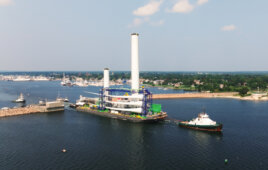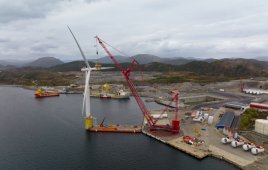By Bill Ziegenhagen, product manager, Zetec
Eddy current technology has long been used in nondestructive testing (NDT) for wind turbine tower welds, drivetrains and a wide range of spot inspections in O&M programs. It’s a fast, accurate, chemical-free method for detecting surface and sub-surface indications that are too small to see with the naked eye, including cracks, pits, corrosion and damage due to impact or fatigue.

During a weld inspection, a flexible surface array probe with just 2 in. of coverage can encapsulate the weld bead, transition zone and heat-affected zones in a single pass. Credit: Zetec
Eddy current testing has the added benefit of producing an electronic inspection record for advanced analysis and reporting, a big advantage over dye penetrant testing (PT) and magnetic particle testing (MT).
Unlike PT or MT, eddy current results are digital and can be analyzed, saved, shared, stored and compared at any time. Eddy current can also “see” through non-conductive coatings like paint without technicians having to pretreat the surface — a time-consuming and messy process.
Eddy current testing involves using a portable instrument and a probe with a coil that fires electronic currents into the material. Eddy current array (ECA) probes have multiple coils that fire at coordinated times and can capture more information in a single pass, transforming the eddy current inspection from a process that might last several minutes per joint to one that takes seconds.
One practical limitation of eddy current technology is that the coils in the probe need to be close to the material for accurate flaw detection and signal quality. It’s a challenge because of the various component geometries, weld shapes, rough surfaces and hard-to-reach areas on a wind turbine.
Consider the inspection of butt welds on a steel tower. Fabricating towers capable of resisting severe stresses and variable loads requires thick, high-strength steel plates and multi-pass complete-penetration butt welds. The technician has to keep the probe closely aligned with the positive curvature of the tower exterior, the positive curvature of the circumferential weld crown bead and the non-uniform surface of the weld itself.
The job is made more complex by how difficult these welds and components are to reach.
Thus, there is a need for a probe design that can keep the excitation coils and sensing devices closely and properly aligned with the surface of the material as the technician applies the probe to the surface. Over the years, probe suppliers have come up with a variety of methods to accomplish this.
Customized probes
One strategy is to design a surface array probe that’s shaped for one specific application or component, like gear teeth, rivets, bolt holes or something that has to be subjected to repeated nondestructive testing.
Using CAD drawings and 3D printing technology, it’s possible to manufacture an eddy current probe that’s precisely formed to fit an exact shape or surface. Though it’s designed to do only one job, a custom-made probe can be extremely effective at producing consistent data acquisition conditions over and over again.
Flexible probes
Another approach is to use an ECA probe with a flexible, durable wear surface that allows the coils to bend and remain nominally perpendicular to the surface when that surface is rough, irregular or complex. In the case of a weld, for example, a flexible surface array probe with just 2 in. of coverage can encapsulate the weld bead, transition zone and heat-affected zones in a single pass.

The effectiveness of an eddy current probe depends on getting the excitation coils and sensing devices aligned with the surface of the material, even when the surface is rough, irregular or complex in shape. Credit: Zetec
Because this type of flexible probe can conform and adapt to different surfaces and contours, it can handle a range of ECA inspections on the same job ticket: for example, a technician can inspect welds on a curved tower and weld joints on turbine rotors with the same flexible surface array probe.
For very high weld crowns, some surface array probes have “+point” coils at the tip of the probe. These types of coils can be especially effective when examining the top of the weld.
One important consideration is the material on the wear surface. The thickness of the wear surface will affect the proximity of the coils to the material as well as the probe’s overall flexibility and eddy current signal quality.
In some cases, the flex circuit may not be durable enough to withstand repeated abrasion against rough metal surfaces. Probe manufacturers offer a variety of materials as a wear surface, including plastic films and abrasion-resistant fabrics like SuperFabric.
Modular approach
Customized and flexible surface array probes can quickly and accurately test a wide range of materials and geometries but the entire assembly must be replaced if one element of the probe wears out or fails.
One new approach to improving the versatility and service life of ECA probes is a modular one. Last year, Zetec introduced Surf-X, a flexible ECA probe with swappable coil sets for specific applications. Each probe is comprised of an electronics module and detachable encoder that can be used interchangeably with different array probe coil sets. Users in the field can switch out a coil set in less than one minute.
Currently, Zetec offers five coil sets, including one set for welds that uses a mix of 32 array coils and two +point coils for complete inspection coverage of butt and t-welds; two versions of very flexible tape probes for inspecting small surface flaws on complex geometries such as turbine dovetails; and another set for a range of surface array testing applications where PT or pencil probes might be used today. The encoder can connect in multiple locations on both the handle and electronics module. The module, encoder, and cables can be re-used, saving time and money.
The coil sets have four wear-surface options: no wear surface on the tape probes for inspecting small indications on smooth materials; a thin UHMW plastic wear surface to protect coils and reduce lift-off; a cloth wear surface for protecting the array coils on smooth or polished surfaces, like gear teeth; and SuperFabric for protecting array coils on rough surfaces like butt and t-welds.
More coverage and versatility
Regardless of whether you use a custom probe shape, a flexible surface array probe or a modular approach, today’s ECA probes provide greater inspection coverage in a fraction of the time compared to PT, MT or pencil probes.
The key is to focus on a probe’s flexibility — literally — in terms of the surfaces and geometries it can handle, and in its ability to help technicians be more productive in their inspections while maximizing the value, versatility, signal quality and service life of the probe.
 Bill Ziegenhagen is a nuclear engineer and former U.S. Navy officer who has spent 13 years as an eddy current product manager at Zetec, which produces non-destructive testing instruments, probes, and software for power generation, oil and gas, aerospace, and other industries. He is based in Snoqualmie, Washington.
Bill Ziegenhagen is a nuclear engineer and former U.S. Navy officer who has spent 13 years as an eddy current product manager at Zetec, which produces non-destructive testing instruments, probes, and software for power generation, oil and gas, aerospace, and other industries. He is based in Snoqualmie, Washington.
Filed Under: Featured




